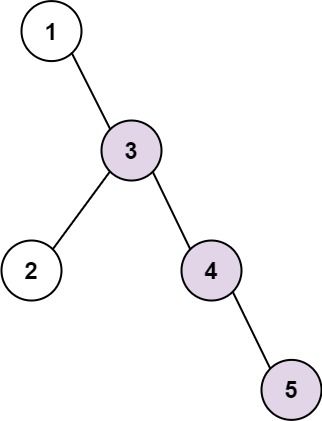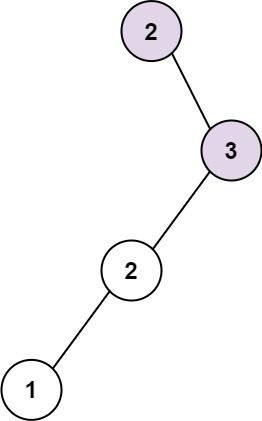Welcome to Subscribe On Youtube
298. Binary Tree Longest Consecutive Sequence
Description
Given the root of a binary tree, return the length of the longest consecutive sequence path.
A consecutive sequence path is a path where the values increase by one along the path.
Note that the path can start at any node in the tree, and you cannot go from a node to its parent in the path.
Example 1:

Input: root = [1,null,3,2,4,null,null,null,5] Output: 3 Explanation: Longest consecutive sequence path is 3-4-5, so return 3.
Example 2:

Input: root = [2,null,3,2,null,1] Output: 2 Explanation: Longest consecutive sequence path is 2-3, not 3-2-1, so return 2.
Constraints:
- The number of nodes in the tree is in the range
[1, 3 * 104]. -3 * 104 <= Node.val <= 3 * 104
Solutions
DFS or BFS.
-
/** * Definition for a binary tree node. * public class TreeNode { * int val; * TreeNode left; * TreeNode right; * TreeNode() {} * TreeNode(int val) { this.val = val; } * TreeNode(int val, TreeNode left, TreeNode right) { * this.val = val; * this.left = left; * this.right = right; * } * } */ class Solution { private int ans; public int longestConsecutive(TreeNode root) { dfs(root); return ans; } private int dfs(TreeNode root) { if (root == null) { return 0; } int l = dfs(root.left) + 1; int r = dfs(root.right) + 1; if (root.left != null && root.left.val - root.val != 1) { l = 1; } if (root.right != null && root.right.val - root.val != 1) { r = 1; } int t = Math.max(l, r); ans = Math.max(ans, t); return t; } } -
/** * Definition for a binary tree node. * struct TreeNode { * int val; * TreeNode *left; * TreeNode *right; * TreeNode() : val(0), left(nullptr), right(nullptr) {} * TreeNode(int x) : val(x), left(nullptr), right(nullptr) {} * TreeNode(int x, TreeNode *left, TreeNode *right) : val(x), left(left), right(right) {} * }; */ class Solution { public: int longestConsecutive(TreeNode* root) { int ans = 0; function<int(TreeNode*)> dfs = [&](TreeNode* root) { if (!root) { return 0; } int l = dfs(root->left) + 1; int r = dfs(root->right) + 1; if (root->left && root->left->val - root->val != 1) { l = 1; } if (root->right && root->right->val - root->val != 1) { r = 1; } int t = max(l, r); ans = max(ans, t); return t; }; dfs(root); return ans; } }; -
# Definition for a binary tree node. # class TreeNode: # def __init__(self, val=0, left=None, right=None): # self.val = val # self.left = left # self.right = right # dfs class Solution: def longestConsecutive(self, root: TreeNode) -> int: maxLen = 0 # curLen: consecutive length until parent node def dfs(root: TreeNode, lastVal: int, curLen: int) -> None: nonlocal maxLen if not root: return curLen = (curLen + 1) if (not lastVal) and root.val == lastVal + 1 else 1 maxLen = max(maxLen, curLen) dfs(root.left, root.val, curLen) dfs(root.right, root.val, curLen) dfs(root, None, 0) return maxLen ############ # Definition for a binary tree node. # class TreeNode(object): # def __init__(self, x): # self.val = x # self.left = None # self.right = None from collections import deque # iterative, bfs class Solution: def longestConsecutive(self, root: TreeNode) -> int: if not root: return 0 max_length = 0 # Queue elements are tuples: (current node, length of consecutive sequence) queue = deque([(root, 1)]) while queue: current, length = queue.popleft() max_length = max(max_length, length) for neighbor in [current.left, current.right]: if neighbor: # Check if neighbor is consecutive if neighbor.val == current.val + 1: queue.append((neighbor, length + 1)) else: queue.append((neighbor, 1)) return max_length ############ class Solution: def longestConsecutive(self, root: Optional[TreeNode]) -> int: def dfs(root: Optional[TreeNode]) -> int: if root is None: return 0 l = dfs(root.left) + 1 r = dfs(root.right) + 1 if root.left and root.left.val - root.val != 1: l = 1 if root.right and root.right.val - root.val != 1: r = 1 t = max(l, r) nonlocal ans ans = max(ans, t) return t ans = 0 dfs(root) return ans -
/** * Definition for a binary tree node. * type TreeNode struct { * Val int * Left *TreeNode * Right *TreeNode * } */ func longestConsecutive(root *TreeNode) (ans int) { var dfs func(*TreeNode) int dfs = func(root *TreeNode) int { if root == nil { return 0 } l := dfs(root.Left) + 1 r := dfs(root.Right) + 1 if root.Left != nil && root.Left.Val-root.Val != 1 { l = 1 } if root.Right != nil && root.Right.Val-root.Val != 1 { r = 1 } t := max(l, r) ans = max(ans, t) return t } dfs(root) return } -
/** * Definition for a binary tree node. * class TreeNode { * val: number * left: TreeNode | null * right: TreeNode | null * constructor(val?: number, left?: TreeNode | null, right?: TreeNode | null) { * this.val = (val===undefined ? 0 : val) * this.left = (left===undefined ? null : left) * this.right = (right===undefined ? null : right) * } * } */ function longestConsecutive(root: TreeNode | null): number { let ans = 0; const dfs = (root: TreeNode | null): number => { if (root === null) { return 0; } let l = dfs(root.left) + 1; let r = dfs(root.right) + 1; if (root.left && root.left.val - root.val !== 1) { l = 1; } if (root.right && root.right.val - root.val !== 1) { r = 1; } const t = Math.max(l, r); ans = Math.max(ans, t); return t; }; dfs(root); return ans; }